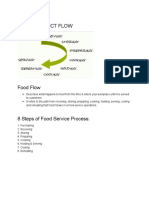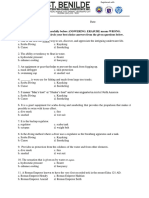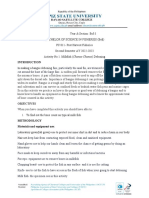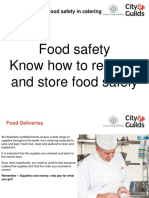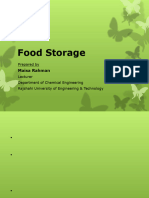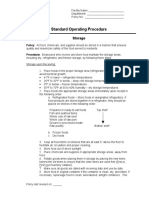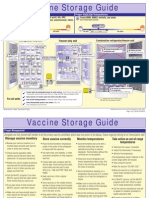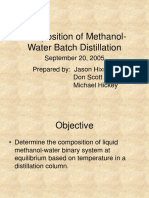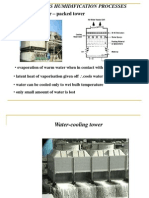0%(1)0% found this document useful (1 vote)
2K viewsRequisites of Dry Storage, Refrigerated and Freezer Storage Areas
Requisites of Dry Storage, Refrigerated and Freezer Storage Areas
Uploaded by
Josanna Pujante TanThis document provides guidelines for proper dry storage, refrigerated storage, and freezer storage. For dry storage, it recommends keeping areas clean and ventilated between 50-70°F and storing foods off the floor and away from walls. For refrigerated storage, it advises maintaining temperatures between 32-40°F and ensuring proper air circulation. For freezer storage, the guidelines state to maintain temperatures at or below 0°F and check temperatures regularly to ensure proper functioning.
Copyright:
© All Rights Reserved
Available Formats
Download as PPTX, PDF, TXT or read online from Scribd
Requisites of Dry Storage, Refrigerated and Freezer Storage Areas
Requisites of Dry Storage, Refrigerated and Freezer Storage Areas
Uploaded by
Josanna Pujante Tan0%(1)0% found this document useful (1 vote)
2K views11 pagesThis document provides guidelines for proper dry storage, refrigerated storage, and freezer storage. For dry storage, it recommends keeping areas clean and ventilated between 50-70°F and storing foods off the floor and away from walls. For refrigerated storage, it advises maintaining temperatures between 32-40°F and ensuring proper air circulation. For freezer storage, the guidelines state to maintain temperatures at or below 0°F and check temperatures regularly to ensure proper functioning.
Original Description:
TLE Grade - 9
Original Title
Tle Partner
Copyright
© © All Rights Reserved
Available Formats
PPTX, PDF, TXT or read online from Scribd
Share this document
Did you find this document useful?
Is this content inappropriate?
This document provides guidelines for proper dry storage, refrigerated storage, and freezer storage. For dry storage, it recommends keeping areas clean and ventilated between 50-70°F and storing foods off the floor and away from walls. For refrigerated storage, it advises maintaining temperatures between 32-40°F and ensuring proper air circulation. For freezer storage, the guidelines state to maintain temperatures at or below 0°F and check temperatures regularly to ensure proper functioning.
Copyright:
© All Rights Reserved
Available Formats
Download as PPTX, PDF, TXT or read online from Scribd
Download as pptx, pdf, or txt
0%(1)0% found this document useful (1 vote)
2K views11 pagesRequisites of Dry Storage, Refrigerated and Freezer Storage Areas
Requisites of Dry Storage, Refrigerated and Freezer Storage Areas
Uploaded by
Josanna Pujante TanThis document provides guidelines for proper dry storage, refrigerated storage, and freezer storage. For dry storage, it recommends keeping areas clean and ventilated between 50-70°F and storing foods off the floor and away from walls. For refrigerated storage, it advises maintaining temperatures between 32-40°F and ensuring proper air circulation. For freezer storage, the guidelines state to maintain temperatures at or below 0°F and check temperatures regularly to ensure proper functioning.
Copyright:
© All Rights Reserved
Available Formats
Download as PPTX, PDF, TXT or read online from Scribd
Download as pptx, pdf, or txt
You are on page 1of 11
REQUISITES OF DRY STORAGE,
REFRIGERATED AND FREEZER
STORAGE AREAS
Dry Storage
Many items such as canned goods, baking
supplies, grains, and cereals may be held
safely in dry storage areas. The guidelines
below should be followed:
• Keep dry storage areas clean with good
ventilation to control humidity and
prevent the growth of mold and bacteria.
• Store dry foods at 50°F for maximum
shelf life. However, 70°F is adequate for
dry storage of most products.
• Place a thermometer on the wall in
the dry storage area.
• Check the temperature of the
storeroom daily.
• Store foods away from sources of heat
and light, which decrease shelf life.
• Store foods off the floor and away
from walls to allow for adequate air
circulation.
Refrigerated Storage
Refrigeration increases shelf life of most
products. Most importantly, refrigeration
slows bacterial growth. Optimal refrigerated
storage conditions can be achieved by
following these guidelines:
• Maintain refrigerated storage spaces at 32-
40°F
• Make thermometers readily observable,
easily readable, and accurate to +3°F.
• Position the temperature sensor to register
the warmest air in the refrigerated space to
ensure adequate cooling.
• Establish the correct refrigerator
temperature by placing a thermometer in a
glass of water in the middle of the
refrigerator. Wait 5 to 8 hours. If the
temperature is not 38-40°F, adjust the
temperature control. Check again after 5-
8 hours.
• Ensure that refrigerators have enough
open, slotted shelving to allow for air
circulation around shelves and refrigerator
walls to maintain proper food
temperatures.
• Ensure that doors have a good seal and
close tightly to maintain the temperature
and the efficiency of the unit. Additionally,
keep doors closed as much as possible.
• Keep a back-up appliance thermometer in
the unit in case of a power outage. If the
refrigerator is still 40°F when the power
returns, the food is safe. The food should
not be consumed if the temperature is held
at 40°F for more than two hours
Freezer Storage
Freezers should be used to store frozen
food when it is received. Optimal frozen
storage conditions can be achieved by
following these guidelines:
• Maintain freezer storage spaces at 0°F or
below.
• Make thermometers readily observable,
easily readable, and accurate to +3°F.
• Position the temperature sensor to
represent the actual storage temperature
or place several thermometers in the unit
to ensure accuracy and consistency.
• Establish the correct temperature in the
freezer by placing a thermometer
between frozen food packages. Wait 5 to
8 hours. If the temperature is not 0-2°F,
adjust the freezer temperature control.
Check again after 5-8 hours.
• Ensure that freezers have enough open,
slotted shelving to allow for air circulation
around shelves and walls to maintain
adequate food temperatures.
• Ensure that doors have a good seal and
close tightly to prevent heat gain.
Additionally, keep doors closed as much
as possible.
• Keep a back-up appliance thermometer
in the unit in case of a power outage. If
the freezer is still 0°F when the power
returns, the food is safe.
You might also like
- NEC FR-358 Instruction ManualDocument12 pagesNEC FR-358 Instruction Manualekim444666No ratings yet
- Food Product FlowDocument12 pagesFood Product FlowDal.giNo ratings yet
- Preventing Foodborne Illness During Eight Steps of Food Service ProcessDocument43 pagesPreventing Foodborne Illness During Eight Steps of Food Service ProcessSamille Joy SanchezNo ratings yet
- SOP StorageDocument2 pagesSOP StorageAnikBudiany0% (2)
- The Food Product FlowDocument18 pagesThe Food Product Flowangelo33% (3)
- Chapter 11 - Combustion PDFDocument12 pagesChapter 11 - Combustion PDFMizwandi ZuandiNo ratings yet
- Dry Storage - TLEDocument11 pagesDry Storage - TLELawrence Conanan100% (1)
- Histo 2Document5 pagesHisto 2Lary Lou VenturaNo ratings yet
- Philippine Independence Position PaperDocument1 pagePhilippine Independence Position PaperKCD MULTITRACKSNo ratings yet
- Final Exam For OutdoorDocument3 pagesFinal Exam For OutdoorAndy Villaflor BalbasNo ratings yet
- TLE7 AFA AGRICROP Q0 M2 Perform Preventive Maintenance v5Document24 pagesTLE7 AFA AGRICROP Q0 M2 Perform Preventive Maintenance v5DM RielNo ratings yet
- AEC 12 - Q1 - 0101 - PS - Economics As A Social ScienceDocument49 pagesAEC 12 - Q1 - 0101 - PS - Economics As A Social ScienceVerfe Tuyogon100% (1)
- Dale Aguirre Bangus DeboningDocument3 pagesDale Aguirre Bangus DeboningVincee SamsonNo ratings yet
- Asus X407uar X407ubr X407ufr SchematicDocument103 pagesAsus X407uar X407ubr X407ufr SchematicRizal MuhammadNo ratings yet
- Script - CheckedDocument13 pagesScript - CheckedFara-mae MaqueNo ratings yet
- Storage Temperatures and Procedures PPT LESSONDocument15 pagesStorage Temperatures and Procedures PPT LESSONkathryn sorianoNo ratings yet
- Sop Not FinalDocument6 pagesSop Not FinalLyadelou FortuNo ratings yet
- Storage Temperatures and ProceduresDocument5 pagesStorage Temperatures and ProceduresIskandar FirdausNo ratings yet
- Cold StorageDocument1 pageCold StorageCidAlexanderRamiNo ratings yet
- Fridge Hygiene FINALDocument2 pagesFridge Hygiene FINALPrasanna NarayananNo ratings yet
- ThawingDocument15 pagesThawingSamiksha SinghNo ratings yet
- Storing Food SopDocument2 pagesStoring Food SopoveroricaNo ratings yet
- Cold Chain SystemDocument52 pagesCold Chain SystemGloria MachariaNo ratings yet
- Ohs W8Document8 pagesOhs W8Angelica Magdamit GicaldeNo ratings yet
- 2.2 Guidelines-On-Proper-Storage-Of-Food-In-RefrigeratorsDocument3 pages2.2 Guidelines-On-Proper-Storage-Of-Food-In-RefrigeratorsSeyha L. AgriFoodNo ratings yet
- Food Safety Storage and Temperature ControlDocument7 pagesFood Safety Storage and Temperature ControlAndrew KillipNo ratings yet
- The Flow of Food-StorageDocument4 pagesThe Flow of Food-StorageKendrickAlbasonCallaoNo ratings yet
- Sop TemperaturesDocument4 pagesSop Temperatureschefs.caravanNo ratings yet
- Refrigerator Réfrigérateur RefrigeradorDocument39 pagesRefrigerator Réfrigérateur RefrigeradorEzequiel GolubNo ratings yet
- SOP StorageDocument3 pagesSOP Storagedickson86100% (3)
- Standard Operating Procedures: Food Storage & LeftoversDocument3 pagesStandard Operating Procedures: Food Storage & LeftoversEngr Muhammad Zubair FarooqNo ratings yet
- Temperature ControlDocument8 pagesTemperature ControlAndreea MariaNo ratings yet
- Unit 203 4 Know How To Recieve and Store Food SafelyDocument14 pagesUnit 203 4 Know How To Recieve and Store Food SafelyItumeleng MakhubelaNo ratings yet
- StoringIssuing - Cost ControlDocument38 pagesStoringIssuing - Cost Controlventi_uhi0% (1)
- Indesit BAN 34 NF PDocument10 pagesIndesit BAN 34 NF PДушко Ћосић0% (1)
- Cold ChainDocument40 pagesCold ChainJSeasharkNo ratings yet
- User'S Operation Manual: Read and Save These InstructionsDocument5 pagesUser'S Operation Manual: Read and Save These InstructionsAdam PutraNo ratings yet
- Food Flow PDFDocument10 pagesFood Flow PDFWeendel VenturaNo ratings yet
- Prevention of Temperature Abuse'' Cross Contamination & Sources'' Importance of Handwashing & Good Personal Hygiene''Document19 pagesPrevention of Temperature Abuse'' Cross Contamination & Sources'' Importance of Handwashing & Good Personal Hygiene''Lorraine TomasNo ratings yet
- Prevention of Temperature Abuse'' Cross Contamination & Sources'' Importance of Handwashing & Good Personal Hygiene''Document19 pagesPrevention of Temperature Abuse'' Cross Contamination & Sources'' Importance of Handwashing & Good Personal Hygiene''Lorraine TomasNo ratings yet
- RIL891-Instruction-manual-Feb-16Document21 pagesRIL891-Instruction-manual-Feb-16shabbir.ayesha1992No ratings yet
- Food Storing and Issuing Control: Principles of Food, Beverage, and Labour Cost Controls, Canadian EditionDocument26 pagesFood Storing and Issuing Control: Principles of Food, Beverage, and Labour Cost Controls, Canadian Editionnur sharmira mohamdNo ratings yet
- Sanitation Procedures and PracticesDocument14 pagesSanitation Procedures and PracticesButters AJNo ratings yet
- Eum0900sa User Manual - 050623Document16 pagesEum0900sa User Manual - 050623sckchrisNo ratings yet
- Huong Dan Su Dung (Tieng Viet Trang 18)Document34 pagesHuong Dan Su Dung (Tieng Viet Trang 18)Nghiêm NguyễnNo ratings yet
- Ch3 - Refrigerator, Water Bath & IncubatorDocument24 pagesCh3 - Refrigerator, Water Bath & IncubatornurazleeyanajihaNo ratings yet
- Storage of FoodsDocument5 pagesStorage of FoodsRebe AngelNo ratings yet
- Chapter 5 Food Storing and Issuing ControlDocument25 pagesChapter 5 Food Storing and Issuing ControlArifin Fu100% (1)
- Food StorageDocument30 pagesFood StorageMaisa RahmanNo ratings yet
- Dawlance ReportDocument6 pagesDawlance ReportTaha ZakiNo ratings yet
- Htu Operating ManualDocument9 pagesHtu Operating ManualJulio CostaNo ratings yet
- SOP StorageDocument3 pagesSOP StorageJessNo ratings yet
- English Cooling Methods Fact SheetDocument1 pageEnglish Cooling Methods Fact Sheetعبدالله عمرNo ratings yet
- Refrigerator-Only Unit Freezer-Only UnitDocument2 pagesRefrigerator-Only Unit Freezer-Only Unitsupanee kittitanyaponNo ratings yet
- Guidelines For Storage and Temperature Monitoring PDFDocument17 pagesGuidelines For Storage and Temperature Monitoring PDFHassan HoudoudNo ratings yet
- Module 5 The Food FlowDocument65 pagesModule 5 The Food Flows8fhfy5m4cNo ratings yet
- Bioref Contigency Plan PDFDocument1 pageBioref Contigency Plan PDFCatarman Doctors Hospital IncNo ratings yet
- navod-WH2310A EDocument34 pagesnavod-WH2310A EPeter FilloNo ratings yet
- Inspection and LabelingDocument1 pageInspection and Labelingsheryarkhalid215No ratings yet
- Food Flow Process ReportDocument22 pagesFood Flow Process ReportQueen AprilNo ratings yet
- Tandard Perating Rocedure: StorageDocument2 pagesTandard Perating Rocedure: StorageJessa Mae AlgarmeNo ratings yet
- Cotes Dehumidifiers CR100-1200: Experts in Humidity ManagementDocument3 pagesCotes Dehumidifiers CR100-1200: Experts in Humidity ManagementXIN NIUNIUNo ratings yet
- Dushman No. Khazina Ruhaniyaat Oct 2018 - CompressedDocument108 pagesDushman No. Khazina Ruhaniyaat Oct 2018 - Compressedsyed mohsinNo ratings yet
- DSCDocument21 pagesDSCPushpinder SinghNo ratings yet
- Coolship CalcDocument8 pagesCoolship CalcNicolas MossoNo ratings yet
- QP 4Document6 pagesQP 4dhyanv0166No ratings yet
- 12th Sprint Reloaded-SolutionsDocument47 pages12th Sprint Reloaded-SolutionsMuhammad Anas BilalNo ratings yet
- Composition of Methanol-Water Batch Distillation: Prepared By: Jason Hixson Don Scott Michael Hickey September 20, 2005Document28 pagesComposition of Methanol-Water Batch Distillation: Prepared By: Jason Hixson Don Scott Michael Hickey September 20, 2005bakhtyar21No ratings yet
- Heat Transfer Final PaperDocument14 pagesHeat Transfer Final PaperGilbert RacinesNo ratings yet
- SECTION 15010: Handbook of FundamentalsDocument5 pagesSECTION 15010: Handbook of FundamentalsAndy WijayaNo ratings yet
- Cc3 Thermodynamics TheoryDocument20 pagesCc3 Thermodynamics TheorySubhradeep GhoshNo ratings yet
- Chilled Water For ESIPDocument8 pagesChilled Water For ESIPSandeep ChawlaNo ratings yet
- HMT QBDocument42 pagesHMT QBMansi KadelNo ratings yet
- Ref Review ProblemsDocument3 pagesRef Review ProblemsGiancarlo SantosNo ratings yet
- Disha Publication Previous Years Problems On Thermodynamics For NEET. CB1198675309Document11 pagesDisha Publication Previous Years Problems On Thermodynamics For NEET. CB1198675309Study UT educationNo ratings yet
- Assignment 1 - 151906 - Conventional Power EngineeringDocument2 pagesAssignment 1 - 151906 - Conventional Power EngineeringSai BalaNo ratings yet
- Thermodynamic Equilibrium in Open Chemical Systems.: The R-Modynamics of Chemical EquilibriaDocument10 pagesThermodynamic Equilibrium in Open Chemical Systems.: The R-Modynamics of Chemical EquilibriayeshiduNo ratings yet
- Comfortvu Bacnet Standart Thermostat TB C Carrier AnzuesDocument57 pagesComfortvu Bacnet Standart Thermostat TB C Carrier Anzuesamerico zambrano contrerasNo ratings yet
- 6035 L2u203 PPT Outcome4Document9 pages6035 L2u203 PPT Outcome4shahin.noktehdan4102No ratings yet
- DMC Template With CGPA Calculation ComputerDocument19 pagesDMC Template With CGPA Calculation Computerabcdefgh100% (1)
- 5 Availability & IrreversibilityDocument4 pages5 Availability & IrreversibilityS Sweet SweetNo ratings yet
- Ni Stir 7401Document30 pagesNi Stir 7401Meta AncetaminaNo ratings yet
- Foester (1960) On Self-Organizing Systems and Their EnvironmentsDocument2 pagesFoester (1960) On Self-Organizing Systems and Their EnvironmentsJuliana Michelon AlvarengaNo ratings yet
- Hkcee Physics - 1.2 Transfer Processes - P.1Document2 pagesHkcee Physics - 1.2 Transfer Processes - P.1Y AdaNo ratings yet
- Solar Air Conditioning System 22Document17 pagesSolar Air Conditioning System 22mamona zaheerNo ratings yet
- MS Samsung Slim Duct PDFDocument2 pagesMS Samsung Slim Duct PDFMacSparesNo ratings yet
- Lect - 9 Normal ShocksDocument14 pagesLect - 9 Normal ShocksAmeena AimenNo ratings yet
- Acr Iii Final Exam QuestionsDocument14 pagesAcr Iii Final Exam QuestionsCAROLYN RhoeNo ratings yet
- BS en 15316-1-2007 (2008) PDFDocument26 pagesBS en 15316-1-2007 (2008) PDFqmarinel100% (1)
- Continous Humidification Processes: Water-Cooling Tower - Packed TowerDocument30 pagesContinous Humidification Processes: Water-Cooling Tower - Packed Towerdrami94100% (1)

